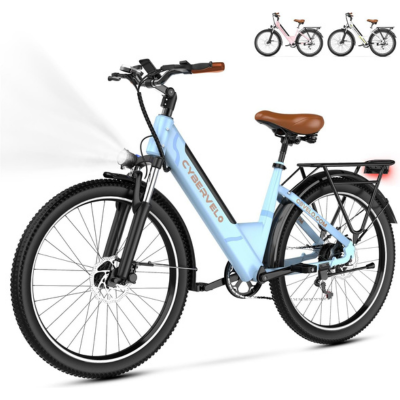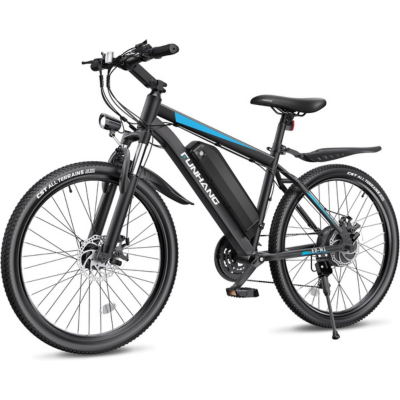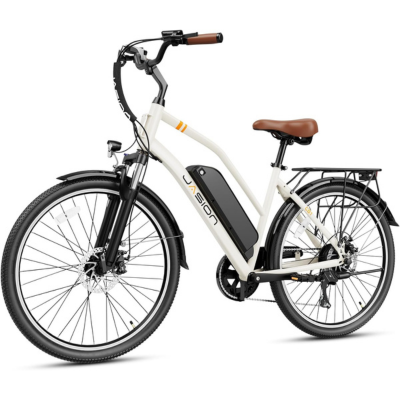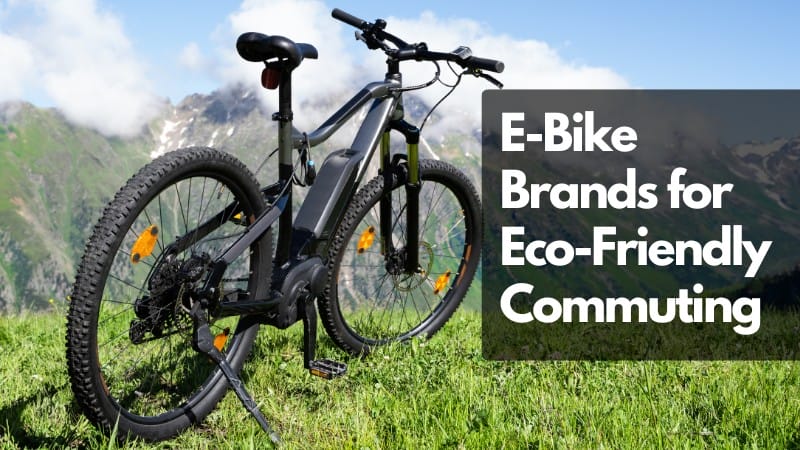The electric bike market is booming — and it’s not just about speed or convenience. Today’s best e-bike brands are redefining what it means to travel sustainably. As cities become more congested and climate goals more urgent, e-bikes offer a powerful, eco-friendly alternative to gas-guzzling vehicles.
Electric bikes are so popular that the supply often can’t meet the demand. Some people are even turning to e-bike conversion kits to make their own bikes electric.
In this guide, we spotlight e-bike brands that go the extra mile — not just in performance, but in sustainability. From ethical manufacturing and low-impact materials to clean energy battery tech and long product lifespans, these companies are leading the way toward a cleaner transportation future.
Whether you’re a daily commuter, weekend adventurer, or someone ready to ditch your car for good, these brands prove that riding electric can be smart, sustainable, and built to last.
3 E-Bike Brands with a Sustainable Edge
1. CYBERVELO: Powering Daily Rides with Clean Commutes in Mind

CYBERVELO may be a newer name in the e-bike space, but it’s already gaining attention for delivering reliable, no-nonsense electric bikes designed for everyday sustainability. The brand focuses on helping riders transition from gas-powered commutes to electric mobility — a shift that reduces personal carbon footprints while easing the load on urban infrastructure.
Where CYBERVELO shines is in its commitment to functional design. Their e-bikes are built with high-efficiency brushless motors and long-range lithium battery systems that balance performance with affordability. Many of their models use aluminum alloy frames — a more recyclable option than carbon fiber or steel — and components that are easy to service or replace, helping extend product lifespan and reduce premature disposal.
While CYBERVELO hasn’t rolled out formal recycling initiatives or carbon offset programs yet, their bikes reflect a mindset of sustainable practicality: get more people out of cars and onto electric two-wheelers. For eco-conscious commuters looking to reduce emissions without breaking the bank, CYBERVELO is a solid, growing option in the e-bike world.
2. Funhang: Affordable Access to Eco-Friendly Transportation

Funhang is on a mission to make electric biking more accessible — and that’s no small feat in a market often dominated by high-end pricing. The brand offers compact, foldable, and urban-ready e-bikes that cater to apartment dwellers, casual riders, and green-minded city explorers.
From a sustainability angle, Funhang leans into space-saving design and energy efficiency. Their folding models reduce storage-related waste (no bike racks or parking woes), and they use rechargeable lithium-ion batteries that can support multiple years of daily use. Though the brand hasn’t fully stepped into sustainability certifications or third-party vetting, the minimalist construction of their e-bikes often means fewer raw materials used — a quieter but real nod to waste reduction.
Funhang could improve its environmental credibility with lifecycle transparency or take-back programs, but even now, their core mission aligns with sustainable living: offer electric bikes that anyone can ride, store, and charge without hassle. By reducing barriers to electric mobility, Funhang helps more people embrace cleaner transportation.
3. Jasion: Built for Exploration, Designed for Longevity

Jasion brings rugged reliability to the e-bike market, combining outdoor readiness with eco-conscious engineering. Their fat tire e-bikes are designed for all-terrain use — encouraging people to explore nature without gas-powered vehicles. In doing so, Jasion subtly promotes a cleaner outdoor lifestyle, where the ride is electric, and the footprint is light.
What sets Jasion apart is its emphasis on durability and battery technology. Their bikes use high-capacity lithium batteries with extended range, minimizing the need for frequent charging and reducing wear and tear. Many models include replaceable components like detachable batteries and modular controls, which make maintenance easy and extend the bike’s lifespan.
Jasion’s sustainability message is built into the product experience rather than flashy green marketing. Their e-bikes encourage car-free recreation and commuting, and their focus on rugged, long-lasting builds reduces product turnover. While the brand would benefit from public-facing commitments to recycling or emissions reduction, Jasion already supports greener lifestyles — one backroad at a time.
Things to Consider When Buying the Best e-Bikes
What Types of E-Bikes Are There?
Just like with regular bikes, in the world of e-bikes, you get different types like road bikes, mountain bikes, commuters, folding bikes, etc.
And these different configurations have their e-parts incorporated in a different way.
Electric Mountain bikes for example will likely have motors with high Nm value or torque, which is important for negotiating slippery slopes.
Cargo and utility bikes benefit from having a low center of weight, so they often have mid-drive motors.
Foldable e-bikes usually have their batteries hidden inside the frame, while commuter or hybrid bikes often have expandable batteries so you can double the distance.
Pro Tip: First of all, you need to know how and where you plan to use your e-bike as every type reviewed is designed to be the best is what it’s made for.
I Can’t See the Motor
When it comes to e-bikes there are three types of motors, each with its own set of benefits and downsides:
- Geared hub drive motor
- Direct-drive hub motor
- Mid-drive motor
A geared hub drive motor is the most common type found on e-bikes today. It is located inside the rear hub of the wheel where it’s often almost concealed by the gears, looking from the side.
These motors are called geared because they have gears on the inside as well, allowing you to select different power ratios.
Hub-driven motors have one-way bearings, so when you’re pedaling and not using the motor, you’re not getting any resistance from the motor.
A direct-drive hub motor is much bulkier, so you can hardly miss it. It doesn’t have any internal gears so it needs to be physically larger to create all the torque you need.
Direct-drive motors don’t have one-way bearings so you can actually use them to slow down without hitting the brakes. Some of the energy created this way is even fed back to the battery.
This type of motor is usually seen on bigger and heavier bikes.
A mid-drive motor is located in the middle of your bike — right between your pedals. Mid-drive motors are great for mountain e-bikes as they put the center of mass much more forward and lower down than hub-drive motors, which benefits the overall handling and performance, especially off-road.
However, these motors put all the power through your drive train, which puts more wear and tear on your chain, derailleur, and rear freewheel.
Pedal Assist System (PAS) vs. Throttle
So, does your bike have a pedal-assist or a throttle?
The truth is this is generally not “either-or”. Actually, I haven’t seen any modern bikes these days that don’t come with pedal-assist (PAS). Throttles are something you can see on some bikes but not the others, as they are not legal in all countries.
The pedal assist engages as you start turning the pedals, and there are usually 5 assist modes, so you can choose how much “help” you’re getting from your motor.
On the other hand, this affects your battery and range. The lower the assistance, the longer you can go.
The throttle works pretty much the same way as a motorcycle throttle. You don’t have to pedal at all, just hit the throttle and coast along.
However, if you’re riding this way, your range decreases significantly.
The throttle comes in handy when you load up your bike with stuff and need to push it, for example through a crowd of people or a narrow path.
Pro Tip: Before you decide what you’re going to get, make sure to test a couple of bikes with a throttle and without, just so you can see what works for you.
How Important is the Battery
Let’s make this one short and sweet. The battery is one of the most important and the most expensive parts of your e-bike. This is not something you want to save on.
Stick to the brands like Samsung, LG, and Panasonic and make sure your battery has enough watt-hours to last you through a day.
Luckily, you have many quality Lithium-ion batteries, so stay away from NiMh, lead-acid, and no-name batteries.
Another important consideration is the way you’re going to charge it.
If you get a bike with a non-removable battery, you’ll need to take the bike wherever the charger is. On the other hand, you’ve already guessed it — removable batteries are much handier but easier to steal.
If you value portability and like having a spare battery, look for those that lock up with a key.
Finally, there is a choice between a generic and proprietary style of battery.
- Generic: easier to find, easier to replace, easier to upgrade, doesn’t look as good
- Proprietary: sourcing depends on the manufacturer, looks sleek
Are E-Bikes Legal Everywhere?
As the street-legality of e-bikes is concerned, most states in the US use a so-called three-tier classification:
Class I
An e-bike that has a motor (max. 750W) that assists only when you’re pedaling, and up to 20 mph. After you reach this speed the motor turns off but you can still pedal. — Example: Trek Verve+ 3
Class II
This e-bike category has a pedal-assist AND a throttle that can propel a bike to and maintain 20 mph without you having to pedal — Example: MaxFoot MF-19
Class III
Class III includes e-bikes that have up to a 750W motor that assists only when you’re pedaling, allowing for maximum assisted speeds up to 28 mph. — Example: Aventon Pace 500

The federal law limits the e-bike speed to 20 mph when using a motor power only.
Many states have specified the speed limit for classes I & II to 20 mph.
Class III is the most restricted and depending on where you live, you may be limited to 28 mph or required to register your bike, wear additional protection, etc.
Do yourself a favor and check your local state and municipality laws before cash changes hands.
Do the Numbers Really Add Up?
The question is, can you choose the best e-bike by looking at numbers only? Are watts, Newton-meters, and watt-hours that important? And what about the manufacturer range claims?
Well, the answer is yes and no.
If you’re comparing two similar bikes, say, from the same manufacturers, it’s clear that a 350W motor will give you more power and more importantly torque (Nm) than a 250W motor.
However, when comparing e-bikes from two different manufacturers, not to mention different classes and price ranges, things can get wildly exciting.
It’s all about compatibility and optimization of the parts. Just like with Apple products.
On paper, the iPhone 12 might have less CPU power, less RAM, less battery capacity, and fewer megapixels, but still be better than the competition.
Why? Because the hardware and software are expertly optimized for performance and power saving.
It’s the same thing with e-bikes.
Although they have fewer watts and Nms than many of their counterparts, Trek bikes are at the top of the list because they use quality parts that make the most out of available power and battery. Not to mention manufacturer warranties and service support.
Pro Tip: You can’t trust the tech specs only, as not all bikes use the top quality parts and engineering.
Final Thoughts: Ride Clean, Choose Consciously
Choosing the right e-bike isn’t just about power, pedals, or price — it’s about principles. The brands we’ve featured here are doing more than building electric bikes; they’re reshaping transportation to be greener, fairer, and more future-proof.
By supporting companies that embrace ethical sourcing, recyclable materials, and low-emission production, you’re not just buying a product — you’re investing in a movement.
As electric bikes continue to shape the future of mobility, let’s make sure sustainability stays in the driver’s seat.


